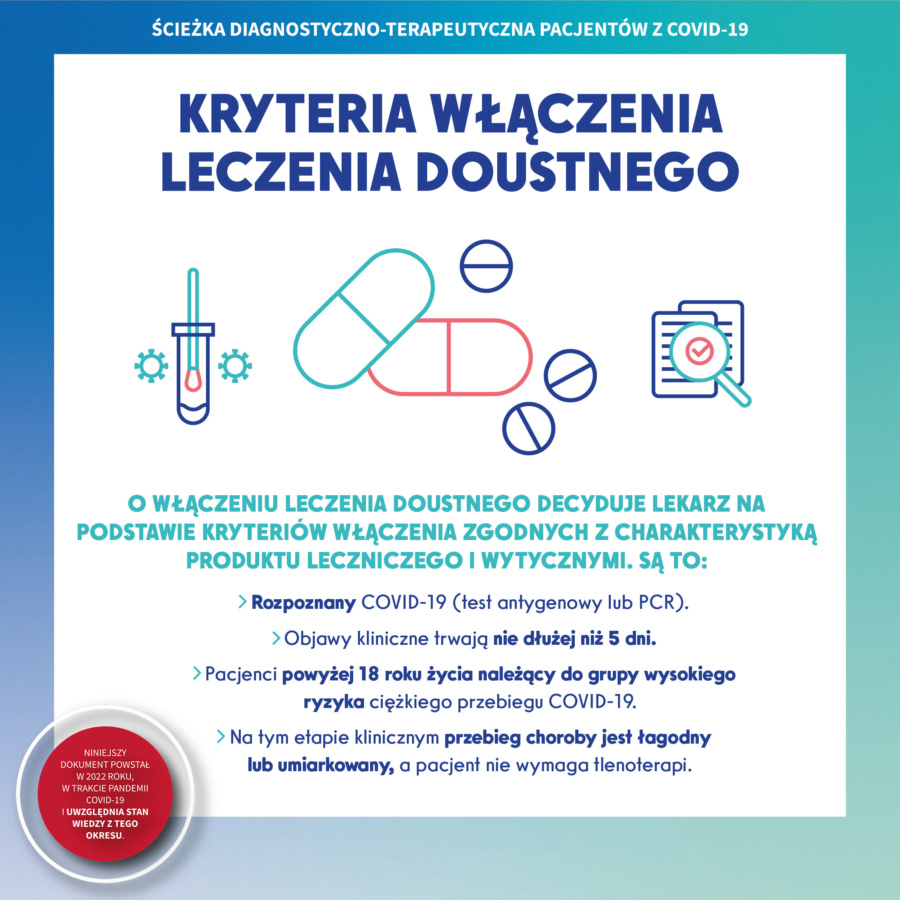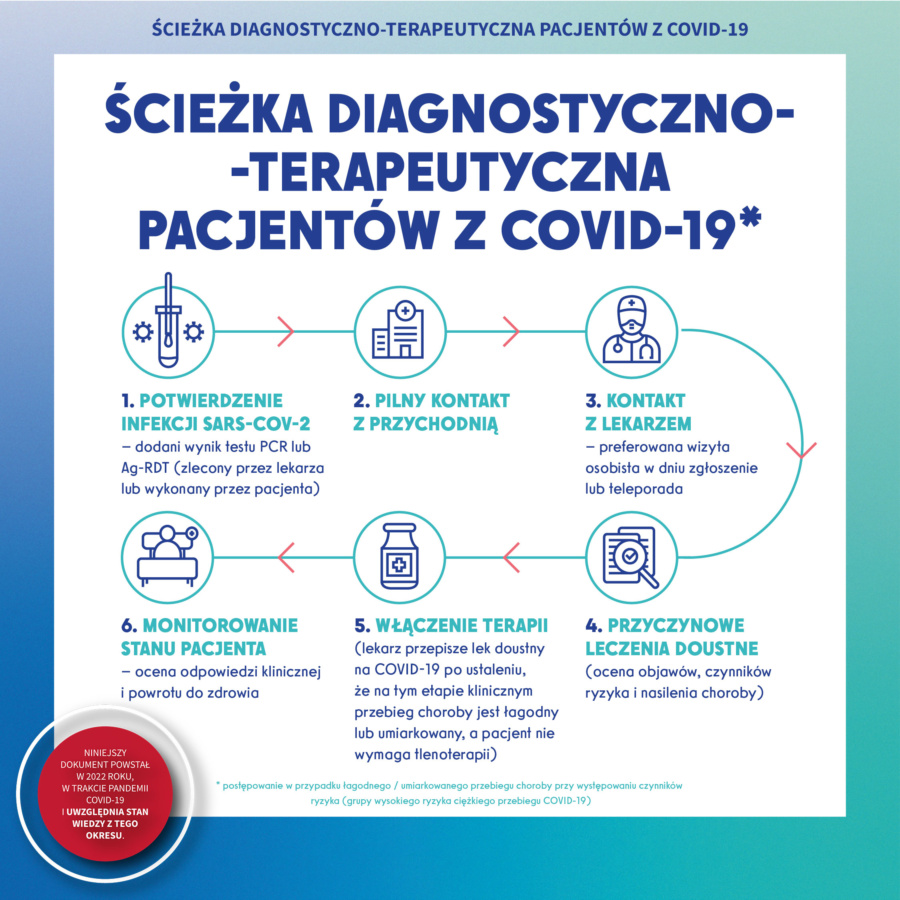Increasing the number of people vaccinated, ensuring testing and access to oral antiviral drugs for those at high risk of severe disease are the main conclusions of the report 'Diagnostic and therapeutic pathway for patients with COVID-19', which was initiated by the Institute for Patients' Rights and Health Education. The authors also call for the preparation of an epidemic strategy for the autumn.
COVID-19 more dangerous than influenza. Coronavirus disease (COVID-19) is an infectious disease caused by the SARS-CoV-2 virus. As a result of infection, most people who become ill with COVID-19 will develop symptoms of mild to moderate severity. Such individuals will recover without special treatment. Others, especially those burdened by chronic co-morbidities and over 60 years of age, may become seriously ill and will require treatment.

During the more than two years of the COVID-19 pandemic, more than 5.9 million Poles became ill and more than 116,000 died. The Sars-Cov-2 virus also indirectly contributed to 200,000 excess deaths due to limited access to healthcare. The highest relative increase was found among those suffering from cardiovascular diseases - 16.69%, diabetes - 15.88%, neurological diseases - 14.63%, digestive diseases - 13.54%, psychiatric diseases - 12.69%, lung diseases - 10.33% and cancer - 4.7%3.
COVID-19 is by no means a fluke. Its mortality rate is and always has been much higher. The overall mortality rate of patients hospitalised with COVID-19 in Poland as of March 2020 was 12.2 per cent, said Professor Jerzy Jaroszewicz, president of the Polish Hepatology Society, head of the Department of Infectious Diseases and Hepatology Clinical Division of the Silesian Medical University
An interdisciplinary disease. COVID-19 is an interdisciplinary disease, so its diagnosis and treatment involves doctors from different specialties. COVID-19 is a disease not only of the lungs, but also of the heart, vessels, skin, kidneys, nervous system, liver and endocrine organs. Today, we know the whole constellation of diseases that worsen the prognosis of COVID-19. This is crucial for the referral of the patient to hospital, but it is also crucial for the use of oral drugs to inhibit COVID-19.
For patients at increased risk of COVID-19 exacerbation, an oral treatment registered in the European Union should be used, which, within five days of diagnosis to the inclusion of therapy, guarantees that this course will be significantly less severe or virtually no symptoms at all. The inclusion of oral therapy should be decided by the doctor on the basis of criteria such as whether the symptoms do not last longer than five days and whether the course of the disease is mild to moderate and the patient does not require oxygen. - explains Jakub Gierczyński, MD, MBA, healthcare system expert, Institute of Healthcare Management, Lazarski University
New approach to the disease needed. Although recent data indicate that the situation has calmed down, the threat from this virus has not gone away. We are moving from a pandemic state to a stage when COVID-19 is treated as a dangerous seasonal infection, much more dangerous than the common cold or influenza. This change should also be followed by a modification of the diagnosis and treatment of this disease.
Therefore, the authors of the report call for preparing now for the autumn wave of the pandemic. Among the necessary measures before a possible next wave of COVID-19, they mention, among other things, supplementing vaccination, also among refugees from Ukraine, rebuilding the testing system and implementing oral therapy against COVID-19, especially for people in high-risk groups. This will help to shift the burden of treating the disease from hospitals to homes and primary care.
Rebuilding the testing system and thus introducing other ways of billing tests in primary care and hospitals and equipping GPs with rapid tests (to differentiate between COVID-19 and influenza, which often have similar symptoms) is crucial. This is because rapid and correct diagnosis is a prerequisite for the inclusion of appropriate antiviral treatment.
Our dream would be to have oral medications registered in the European Union available in Poland for early outpatient treatment in at-risk groups, which include people over 60. age, people with multimorbidity, hypertension, diabetes, circulatory insufficiency, COPD, cancer, immunosuppressed patients or, finally, people who have not been vaccinated for COVID-19 Dr Michał Sutkowski, MD, PhD, an expert at Lazarski University and president of Warsaw Family Doctors.
The crucial 5 days.It is important to remember that antiviral drugs only work when the SARS-CoV-2 coronavirus is multiplying. That is, very early on. In COVID-19, as in other infectious diseases, the virus multiplies briefly. We therefore have a very short therapeutic window - so antiviral treatment must be administered as early as possible, optimally before symptoms appear, preferably very soon after infection. At the latest within four or five days of the onset of symptoms. This is very important and affects the distribution of such a drug, because you need to reach the patient within the first five days.
COVID-19 patient pathway A model diagnostic and therapeutic pathway for a patient with COVID-19 has been developed by the World Health Organisation (WHO) and is regularly updated on the WHO website. It is intended to be a tool to assist health care professionals in visualising the current clinical and te- raapeutic recommendations to be included in the care plan for patients with COVID-19. Local diagnostic and therapeutic pathways should be based on clinical guidelines from scientific societies, which are developed on the basis of reliable scientific evidence (EBM) and should be followed by multidisciplinary care teams to ensure effective and safe patient care.
The treatment regimen is very simple: I know I have been infected, if I take this drug up to five days after the infection and continue to take it for the next five days, we estimate that there is an 80-90 per cent reduction in the risk of hospitalisation and death from COVID-19," says Professor Krzysztof J. Filipiak, MD, cardiologist, rector of the Maria Sklodowska-Curie Medical University in Warsaw, and president of the Polish Society for the Advancement of Medicine - Medicine XXI.
Download the report: REPORT_Patient_path_with_COVID-19


